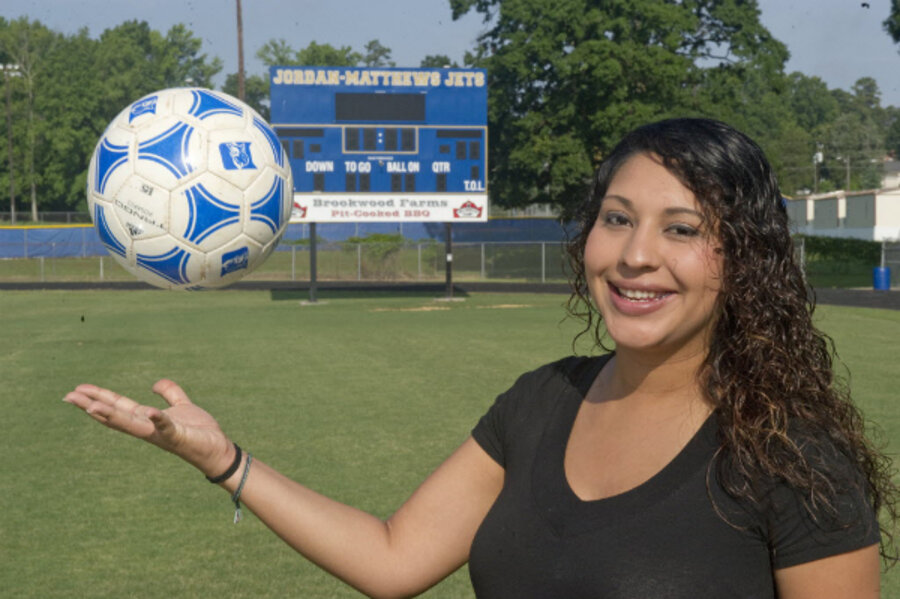Immigration and assimilation: Soccer and prom are part of her American-ness
Loading...
| Siler City, N.C.
When Brenda Calderon arrived in this small town in 1996, there were hardly any other Latinos around. Her family was at the beginning of a wave of immigration to the United States from Mexico and Central America that would eventually transform the town, state, and much of the Southeast.
Ms. Calderon was 7 at the time. Her family came from the coast of Guatemala, where they lived in a two-bedroom house with a corrugated tin roof. She remembers a place that was dusty and humid, with hungry dogs and trash in the streets, and chaotic traffic with no stoplights or stop signs. In North Carolina, everything seemed newer and cleaner; even the walls looked whiter. But at the time, very few people spoke Spanish.
To Calderon, being an American meant finally being part of a unified family. Her father had left Guatemala to work – without papers – on farms in Texas in 1988, the year she was born.
"[E]very time he would go home for Christmas, I remember me and my sister would hide under the bed ... scared to talk to him." Calderon says. "So my mom was like, 'Either he comes home or we go with him, because we want to be a family again.' "
After several tries, her dad secured permanent legal residency in the US for the whole family, and they settled here, where one of Calderon's uncles lived and jobs were plentiful. Her mother told her the move would offer them a better life. And Calderon discovered it was true.
Still, the adjustment was hard. She admits she cried every night her first three months here. There were only one or two other Latina girls in Calderon's class. She didn't even know enough English to ask the school-bus driver where to get off.
Her challenges might have been smaller if her family had moved to a place where there was an established Hispanic population, like the Southwest.
Over time, things got easier: To Calderon, assimilation means getting used to unfamiliar things and people, a different culture and language. By any standard, she has done that. She learned English and became a star student and athlete, obtained US citizenship, and became the first person in her family to graduate from college, getting a BA in exercise and sports science from the University of North Carolina at Chapel Hill. In 2012, she married a US Marine and is now pregnant with their first child.
Calderon also reached out to other immigrant children who had moved here and helped them acclimate. One of her teachers, John Phillips, saw this when Calderon became captain of her high school soccer team: "She had such a good heart. You know how girls can get kind of catty toward each other? When they wouldn't want to accept a [new] girl ... Brenda would smooth it over and say, 'This is our teammate.' And she would take her under her wing."
But even now, at 24, Calderon has moments when she doesn't feel part of the American mainstream.
"Whenever I'm new to a place, I'm always afraid that they're going to notice that I wasn't from here, or that I'm from somewhere else, or that I wasn't born here," she says, with a hint of a Spanish inflection flavoring her slight Southern twang. "Can they actually tell my accent? And then it's like, will they accept me?"
Calderon feels most American when she's playing soccer – because in Guatemala, soccer is just for males. "And so, having the opportunity here – that made me feel like, wow, yeah, I'm here," she explains. "Because in America, even if you're a guy or a girl, you could play whatever sport you like."
She identifies with influences from both of her countries. From her life in Guatemala, Calderon learned the importance of church and family. For Mr. Phillips, that accounts for why Calderon got married after just a six-month courtship. "To me, that was still a little holdover from the roots," he says. "I do think that call to family, that had something to do with it."
From her life in the US, Calderon has decided to be less rigid with her kids than her parents were with her: "I am definitely going to let them have sleepovers. And [go to] prom. Because it was hard for us to assimilate when our parents were saying, 'no, no, no.' "
But apparently, life in the US has changed her parents, too. Her father likes her playing soccer. And when she's visiting Guatemala and encourages her male cousins to make their own coffee, and not lean on the women, her mother laughs, and agrees that's the way things should be.







